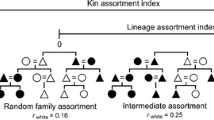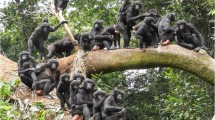Summary
-
1.
When social groups of free-ranging rhesus monkeys on Cayo Santiago, Puerto Rico, undergo fission, they usually divide between genealogies.
-
2.
If a genealogy divides, it is usually between an eldest daughter with her family and the rest of the genealogy.
-
3.
The separation of the eldest daughter from her genealogy is the extreme case of peripheralization of low-ranking females among rhesus monkeys.
-
4.
The founders of new groups that disperse from the former home range are likely to be subordinate individuals in the parent group, as predicted by Christian (1970).
-
5.
The dispersal of families as units is likely to lead to ‘lineal effects’ (Neel and Salzano, 1967) in the genetical substructure of the population.
Similar content being viewed by others
References
Altmann, S.A.: A field study of the sociobiology of rhesus monkeys. Macaca mulatta. Ann. NY Acad. Sci. 102, 338–435 (1962)
Breuggeman, J.A.: Parental care in a group of free-ranging rhesus monkeys. Macaca mulatta). Folia Primatol. 20, 178–210 (1973)
Chagnon, N.A.: Genealogy, solidarity, and relatedness: Limits to local group size and patterns of fissioning in an expanding population. Yearb. Phys. Anthropol. 19, 95–110 (1975)
Chepko-Sade, B.D.: Division of Group F at Cayo Santiago. Am. J. Phys. Anthropol. 41, 472 (1974)
Chepko-Sade, B.D., Olivier, T.J.: Coefficient of genetic relationship and the probability of intragenealogical fission in Macaca mulatta. Behav. Ecol. Sociobiol. (in press) (1979)
Cheverud, J.M., Buettner-Janusch, J., Sade, D.S.: Social group fission and the origin of intergroup genetic differentiation among the rhesus monkeys on Cayo Santiago. Am. J. Phys. Anthropol. 49, 449–456 (1978)
Cheverud, J.M., Buikstra, J.E.: A study of intragroup biological change induced by social group fission in Macaca mulatta using discrete cranial traits. Am. J. Phys. Anthropol. 48, 41–46 (1978)
Chivers, D.J.: The siamang and the gibbon in the Malay in Peninsula. In: Gibbon and siamang. Rumbaugh, D.M. (ed.). Basel: S. Karger 1972
Christian, J.J.: Social subordination, population density, and mammalian evolution. Science 168, 84–90 (1970)
Count, E.W.: The lactation complex. A phylogenetic consideration of the mammalian mother/ offspring symbiosis, with special reference to Man. Homo 18, 38–54 (1967)
Drickamer, L.C., Vessey, S.H.: Group changing in free-ranging male rhesus monkeys. Primates 14, 359–368 (1973)
Duggleby, C.R.: Blood group antigens and the population genetics of Macaca mulatta on Cayo Santiago. II. Effects of social group division. Yearb. Phys. Anthropol. 20, 263–271 (1976)
Duggleby, C.R.: Blood group antigens and the population genetics of Macaca mulatta on Cayo Santiago. I. Genetic differentiation of social groups. Am. J. Phys. Anthropol. 48, 35–40 (1978)
Fox, G.J.: Some comparisons between siamang and gibbon behavior. Folia Primatol. 18, 122–139 (1972)
Fox, G.J.: Peripheralization behavior in a captive siamang family. Am. J. Phys. Anthropol. 41, 479 (1974)
Furuya, Y.: An example of fission of a natural troop of Japanese monkeys at Gaguysan. Primates 2, 149–177 (1960)
Furuya, Y.: On the fission of troops of Japanese monkeys. Primates 9, 323–349 (1968)
Furuya, Y.: On the fission of troops of Japanese monkeys (Part II). Primates 10, 47–60 (1969)
Goodall, J. van Lawick: Mother-offspring relationships in free-ranging chimpanzees. In: Primate ethology. Morris, D. (ed.). London: Weidenfeld and Nicolson 1967
Hausfater, G.: Intergroup behavior of free-ranging rhesus monkeys (Macaca mulatta). Folia Primatol. 18, 78–107 (1972)
Heatwole, H., Sade, D.S., Hildreth, R.W.: Herpetofauna of Cayo Santiago and Cayo Batata. Caribb. J. Sci. 3, 1–5 (1963)
Jolly, A.: The evolution of primate behavior. Simons, E.L., Pilbeam, D. (eds.) New York; Macmillan 1972
Koford C.B.: Group relations in an island colony of rhesus monkeys. In: Primate social behavior. Southwick, C.H. (ed.) Princeton, New Jersey: D. Van Nostrand 1963
Koford, C.B.: Population changes in rhesus monkeys: Cayo Santiago, 1960–1964. Tulane Stud. Zool. 13, 1–7 (1966)
Koyama, N.: Changes in dominance rank and division of a wild Japanese monkey troop in Arashiyama. Primates 11, 335–390 (1970)
Lindberg, D.G.: The rhesus monkey in North India: An ecological and behavioral study. In: Primate behavior: Developments in field and laboratory research, Vol. 2. Rosenblum, L. (ed.). New York: Academic 1971
Missakian, E.A.: Genealogical and cross-genealogical dominance relations in a group of free-ranging rhesus monkeys (Macaca mulatta) on Cayo Santiago. Primates 13, 169–180 (1972)
Missakian, E.A.: The timing of fission among free-ranging rhesus monkeys. Am. J. Phys. Anthropol. 38, 621–624 (1973a)
Missakian, E.A.: Genealogical mating activity in free-ranging rhesus monkeys (Macaca mulatta) on Cayo Santiago. Behaviour 45, 224–241 (1973b)
Missakain, E.A.: Mother-offspring relations in rhesus monkeys. Arch. Sex. Behav. 3, 135–141 (1974)
Nash, L.T.: Troop fission in free-ranging baboons in the Gombe Stream National Park, Tanzania. Am. J. Phys. Anthropol. 44, 63–77 (1976)
Neel, J.V., Salzano, F.M.: Further studies on the Xavante Indians. X. Some hypothesis-generalizations resulting from these studies. Am. J. Hum. Genet. 19, 554–574 (1976)
Olivier, T.J., Ober, C., Buettner-Janusch, J.: Genetics of group fissions on Cayo Santiago. Am. J. Phys. Anthropol. 48, 424 (1978)
Sade, D.S.: Some aspects of parent-offspring and sibling relations in a group of rhesus monkeys, with a discussion of grooming. Am. J. Phys. Anthropol. 23, 1–18 (1965)
Sade, D.S.: Ontogeny of social relations in a group of free-ranging rhesus monkeys (Macaca mulatta Zimmerman). Unpublished doctoral disseration, University of California, Berkeley (1966)
Sade, D.S.: Inhibition of son-mother mating among free-ranging rhesus monkeys. Sci. Psychoanal. 12, 18–38 (1968)
Sade, D.S.: Sociometrics of Macaca mulatta I. Linkages and cliques in grooming matrices. Folia Primatol. 18, 196–223 (1972a)
Sade, D.S.: A longitudinal study of social behavior of rhesus monkeys. In: The functional and evolutionary biology of primates. Tuttle, R. (ed.). Chicago, Aldine Atherton 1972b
Sade, D.S., Cushing, K., Cushing, P., Dunaif, J., Figueroa, A., Kaplan, J.R., Lauer, C., Rhodes, D., Schneider, J.: Popilation dynamics in relation to social structure on Cayo Santiago. Yearb. Phys. Anthropol. 20, 253–262 (1976)
Southwick, C.H., Beg, M.A., Siddiqi, M.R.: Rhesus monkeys in North India. In: Primate behavior. DeVore, I. (ed.). New York Holt, Rinehart and Winston 1965
Wilson, E.O.: Sociobiology. Cambridge, Mass.: Belknap Press of Harvard University Press 1975
Author information
Authors and Affiliations
Rights and permissions
About this article
Cite this article
Chepko-Sade, B.D., Sade, D.S. Patterns of group splitting within matrilineal kinship groups. Behav Ecol Sociobiol 5, 67–86 (1979). https://doi.org/10.1007/BF00302696
Received:
Issue Date:
DOI: https://doi.org/10.1007/BF00302696




